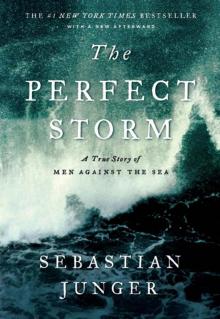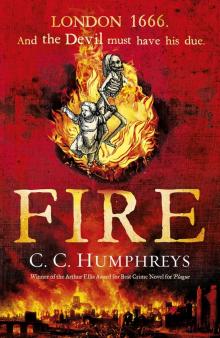Fire Read online
FIRE
ALSO BY SEBASTIAN JUNGER
The Perfect Storm
FIRE
SEBASTIAN JUNGER
W. W. NORTON & COMPANY
NEW YORK LONDON
Copyright © 2001 by Sebastian Junger
All rights reserved
Grateful acknowledgment is made to the following publications, where many of the pieces in this book originally appeared, in slightly different form:
Harper’s: “Dispatches from a Dead War,” August 1999
Men’s Journal: “Line of Fire,” October 1993; “Blow Up,” November 1994; “Escape from Kashmir,”
April 1997
National Geographic Adventure: “Colter’s Way,” Spring 1999; “The Lion in Winter,” March/April 2001 Outside: “The Whale Hunters,” October 1995
Vanity Fair: “Kosovo’s Valley of Death,” July 1998; “The Forensics of War,” October 1999; “The Terror
of Sierra Leone,” August 2000
The portions of “Dispatches from a Dead War” written by Scott Anderson are reprinted by permission of International Creative Management, Inc. Copyright © 1999 by Scott Anderson.
“Editor’s Note” to “Dispatches from a Dead War” Copyright © 1999 by Harper’s Magazine. All rights reserved. Reproduced from the August issue by special permission.
For information about permission to reproduce selections from this book, write to Permissions,
W. W. Norton & Company, Inc., 500 Fifth Avenue, New York, NY 10110
ISBN: 978-0-393-07705-6 (e-book)
W. W. Norton & Company, Inc., 500 Fifth Avenue, New York, N.Y. 10110
www.wwnorton.com
W. W. Norton & Company Ltd., Castle House, 75/76 Wells Street, London W1T 3QT
This book is dedicated to
Ellis Settle, 1924–1993
Contents
Introduction
FIRE (1992)
BLOWUP: WHAT WENT WRONG AT STORM KING MOUNTAIN (1994)
THE WHALE HUNTERS (1995)
ESCAPE FROM KASHMIR (1996)
KOSOVO’S VALLEY OF DEATH (1998)
DISPATCHES FROM A DEAD WAR (1999)
COLTER’S WAY (1999)
THE FORENSICS OF WAR (1999)
THE TERROR OF SIERRA LEONE (2000)
THE LION IN WINTER (2001)
Acknowledgments
Introduction
In 1989, when I was in my late twenties, I saw a magazine photo of half a dozen forest fire fighters taking a break on the fire line. They wore yellow Nomex shirts and hard hats and had line packs on their backs and were leaning on their tools in a little meadow, watching the forest burn. In front of them was a wall of flame three hundred feet high. There was something about the men in that photo—their awe, their exhaustion, their sense of purpose—that I wanted in my life. I tacked the photo to my wall and lived with it for a whole winter.
It was an uninspiring time in my life. I was living in a grim little apartment in Somerville, Massachusetts, I’d quit waiting tables, and I had vague ideas of making my living as a writer. The only good thing I had going on was an intermittent job—more of an apprenticeship, really—working as a climber for a tree company. I’d met a guy in a bar who showed me an enormous scar across his knee from a chain saw accident, and offered me a job. He said he’d teach me to climb if I worked for him whenever he needed someone. I agreed. I climbed trees over houses, trees over garages, trees over telephone lines. I climbed trees that were twenty feet high and swayed from my weight; I climbed others that were 150 years old and had branches so big that holding them was like hanging from the neck of an elephant. Some of the trees had to be taken down; some just had to be pruned. All of them terrified me. I learned to work without looking down. I learned to work without thinking too directly about what I was doing. I learned just to do something regardless of how I felt about it.
Ultimately, I hoped that the work I was doing might lead to a job fighting wildfire. I knew that chain saws were used on fires—one of the guys in my photo had one over his shoulder—and I thought that maybe if I showed up out West with my saw, I could get onto a crew. With fires that big, it seemed that they might take anyone they could get.
That turned out to be emphatically untrue. Forest fires are as much a job opportunity as a natural calamity, and there is a lot of competition to get onto the crews. I made some calls and was told that I had to work for a couple of years on a secondary crew before I could even apply for a full-time position fighting wildfire and that even the secondary crews were hard to get onto. I also needed a “fire card,” which meant that I had to pass a training course, but it admitted only people who were already working in one of the government agencies involved in wildfire. I gave up on the idea of fighting fire and stayed East to continue working in the trees.
As jobs go, climbing was hard to beat. I got in very good shape. I lost my fear of heights. I started making very good money. I would bid on jobs, subcontract out the ground work, and do the climbing myself. The amount I made depended on how fast I worked and how well I priced the job. I made two hundred dollars a day, five hundred a day, a thousand a day. Some days I climbed with such confidence that I almost felt that I didn’t need to use a rope; other times I was filled with such clumsy fearfulness that I could hardly get off the ground.
My experience as a climber culminated one clear, cold November day, when the owner of a tree company asked me to give him a price on a very dangerous job. A large tree had split down the middle, and the bulk of the tree was still balanced in a tiny piece of trunk. Working in a tree like that would be risky because it was unstable, and if it came down unexpectedly, the climber would almost certainly be killed. I walked around the property, looked at the tree from various angles, and told him, “Five hundred dollars.” He shrugged and agreed. It wasn’t worth five hundred dollars to go up into that tree—it wasn’t worth any amount—but I saw another way to do it. On either side of the property were two taller trees that were roughly lined up with the one in question. I climbed both of the taller trees, set up a tension line between them, clipped into it, and pulled myself hand over hand until I was directly over the tree that had to come down. I rappelled down into it and began working. If it fell out from under me, I was still safe. I limbed the tree out and then dropped the trunk in sections. It took two hours. At the time it felt like the best thing I’d ever done.
Inevitably I was going to have an accident—almost every climber I knew had—and mine came while I was pruning a small elm in Wellfleet, Massachusetts. I was in a hurry, cutting too quickly, and the next thing I knew, I’d hit the back of my leg with the chain saw and exposed my Achilles tendon. At first the wound didn’t hurt much and barely bled, but it shook me up badly; if I’d severed the tendon, I could have had problems my whole life. The accident was sloppy and unfortunate, but it made me realize that I didn’t want to be a climber and struggling writer forever. I was thirty years old; I should either tackle a book project or get out of the writing business altogether.
The idea for a book came to me gradually, while I was recovering from my injury. What about a book on dangerous jobs? Logging, commercial fishing, drilling for oil: They all were jobs that society depended on, and they were vastly more dangerous than the sorts of adventure sports that were becoming so fascinating to the public. Six months later—with no magazine assignment and certainly no book contract, but with a huge measure of last-ditch determination—I flew to California, rented a car, and drove to Boise, Idaho. One hot day in late July 1992 I presented myself at the smoke jumper loft adjacent to the Boise airport and explained my intention to write about wildfire. The next day, to my amazement, I was in a government helicopter looking down at the Flicker Creek fire.
The result was a long piece on forest fire fighting that I env
isioned as the first chapter in my book on dangerous jobs. Parts of it were published as a magazine article, but the rest sat in a drawer while I went on to tackle other projects. The next topic was commercial fishing and focused on a Gloucester swordfishing boat named the Andrea Gail that was lost with all hands during a huge storm in 1991. (That chapter took on a life of its own and eventually became The Perfect Storm.) Finally, I wanted to write about war reporters, a topic that had an added appeal because I could always try to do that if my book-writing career didn’t work out. In July 1993 I flew to Vienna, Austria, and walked into the Associated Press office and asked if they needed any help in Bosnia. The answer was no. I went anyway. Two weeks later I was in Sarajevo, in the middle of the civil war.
I think it’s fair to say that I had absolutely no idea what I was doing. I learned quickly, though. I started doing a little free-lance radio reporting; I wrote a couple of newspaper articles; I watched and tried to emulate the other journalists. Half of them were as inexperienced as I was—for the most part, our credentials simply stemmed from the fact that we were there—but we all had one thing in common: We were absolutely mesmerized by what was going on around us. None of the journalists whom I knew wanted to leave the war, ever; none of them felt that it was anything less than the most important event in their lives.
I still don’t fully understand why that may be. What is this fascination that roots fire fighters in their tracks while three-hundred-foot flames twist out of a stand of spruce? Why do journalists—I’ve done this myself—crawl up to front lines even though there’s almost no information of any journalistic value there? It’s tempting to draw some dreadful conclusion about the inherent voyeurism of humans, but I think that would be missing the point. People are drawn to those situations out of an utterly amoral sense of awe that has nothing to do with their understanding of the larger tragedy. Awe is one of those human traits, like love or hate or fear, that overpower almost everything else we believe in, at least for a little while. Some people experience awe when they are in the presence of what they understand to be God; others experience it during a hurricane or a rocket attack. In a narrow sense, these situations are all the same: They completely override the concerns of our puny human lives.
I never wrote my book on dangerous jobs; my fascination with those kinds of stories developed into a general passion for foreign reporting. The stories in this book all deal, in one way or another, with people confronting situations that could easily destroy them. I should make it clear that as a journalist I was not in their shoes; I was rarely in serious danger, and I rarely lacked a quick way out. I had my own fears to confront, though. Stepping off an airplane to work in a foreign country is one of the most terrifying feelings I know, not because something bad might happen to me but because I’m convinced that I’m going to fail. You have two weeks to understand a completely alien culture, find a story that no one has heard of, and run it into the ground. It never feels even remotely possible.
But it is. And in the process of doing my work, I have had the honor of witnessing, up close, the awful drama of human events. Like the fire fighters in my old photo, I have found it impossible to turn away.
Annapolis, Maryland, 2001
FIRE
FIRE
1992
Late in the afternoon of July 26, 1989, a dry lightning storm swept through the mountains north of Boise, Idaho, and lit what seemed like the whole world on fire.
A dry lightning storm is a storm where the rain never reaches the ground. It evaporates in midair, trailing down from swollen cumulus clouds in long, graceful strands called virga. The electrical charges from a dry storm do not trail off before they hit the ground, however; they rip into the mountains like artillery. On July 26, 1989, lightning was hitting the upper ridges of the Boise National Forest at the rate of a hundred strikes an hour. Automatic lightning detectors at the Boise Interagency Fire Center were registering, all over the western states, rates up around two thousand an hour. By nightfall 120 fires had caught and held north of Boise, little one-acre blazes that eventually converged into a single unstoppable, unapproachable front known as the Lowman fire.
For the first three days Lowman was simply one among hundreds of fires that were cooking slowly through the parched Idaho forests. Around four o’clock in the afternoon of July 29, however, the flames reached some dead timber in a place called Steep Creek, just east of the town of Lowman, and the fire changed radically. The timber was from a blowdown two years earlier and was so dry that when the flames touched it, the entire drainage went up. The fire created its own convection winds, making the fire burn hotter and hotter until the fire behavior spiraled completely out of control. Temperatures at the heart of the blaze reached two thousand degrees. A column of smoke and ash rose eight miles up into the atmosphere. Trees were snapped in half by the force of the convection winds.
The fire rolled across Highway 21 and right through the eastern edge of town, detonating propane tanks and burning twenty-six buildings to the ground. A pumper crew was trapped at the Haven Lodge, and they hid behind their truck and finally stumbled out of the blaze an hour later, safe but nearly blind. The fire had attained a critical mass and was reinforcing itself with its own heat and flames, a feedback loop known as a fire storm. The only thing people can do, in the face of such power, is get out of the way and hope the weather changes.
Which they did, and which it did, but not until a month later, after forty-six thousand acres of heavy timber had been turned to ash.
I saw the site of the Lowman fire in 1992, three years afterward, when the ponderosa seedlings were already greening the hillsides. A roadside plaque said that eight million ponderosa and Douglas fir would be hand-planted by the mid-1990s. The plaque went on to describe how the land had been treated with enzymes so that water and microorganisms could penetrate soil that was now seared to the consistency of hard plastic. Thousands of flame-killed trees had been dropped laterally along the slopes to keep the land from washing away, and thirty thousand acres had been planted with grass and fast-growing bitterbrush. In a hundred years, more or less, the area would again look the way it once had.
I was driving a big, painfully beautiful loop from Ketchum, Idaho, around the Sawtooth Mountains and down the South Fork of the Payette River toward Boise. It was late afternoon when I drove through the Lowman burn, and the quiet darkness of the dead valleys depressed me. The West was well into one of the worst droughts of the century, and I was out there to see the wildfires that it was sure to produce. My idea was to go to Boise—where all the fire-fighting resources were coordinated—tell them I was a writer, and hope they let me on afire.
I pulled off down an old logging road and pitched my tent in a clear-cut. It seemed to get dark very quickly that night, and I cooked spaghetti on my camping stove and went to sleep listening to the weekend traffic die down on Highway 21. The Lowman fire, I’d heard, had burned so hot that Highway 21 had melted. There were places, I’d heard, where fire trucks had left their tread marks as they rushed from Boise to fight the flames.
In 1965 the U.S. government established the Boise Interagency Fire Center to coordinate the three federal agencies—the Bureau of Land Management (BLM), the Forest Service, and what was then known as the Weather Bureau—that were engaged in fighting wildfire in America. The Bureau of Indian Affairs, the National Park Service, and the Fish and Wildlife Service were added later, and the name was ultimately changed to the National Interagency Fire Center. Two years after BIFC was established, the Northern Rockies were hit with a catastrophically bad season that culminated in the Sundance fire in northern Idaho. BIFC managed to deploy thirteen thousand men and thousands of tons of supplies, prompting a study by the Office of Civil Defense, which was trying to figure out how to handle a similar crisis in the event of a nuclear war.
BIFC is located next to the Boise airport, across the interstate, south of town. The lobby is filled with the sort of display that, were you even vaguely inclined toward a j
ob fighting fire, would make you move out west on the spot. There is a smoke jumper mannequin in full jump gear, including a wire face mask for when the jumper goes crashing into the treetops. There is a board with everything—food, medical supplies, tools—a jumper needs for forty-eight hours on a fire. There are color photos of air tankers dropping retardant and sheets of flame rising from stands of trees. One photo shows a fire in dense forest on the Umpqua National Forest in Oregon. “The total-timber jump spot,” the caption reads, “trees in this photo are between 80 and 125 feet tall. Five of six smokejumpers committed to this fire ‘hung up’ in trees, thus the rope carried in the leg pocket for a ‘let-down.’ The fire was stopped at a quarter-acre.”
A short, powerful man named Ken Franz—one of the Boise smoke jumpers, as it turned out—spotted me loitering in the lobby and came over to investigate. I told him I was interested in wildfire, and he motioned me into a cluttered conference room and sat me down at a long table to tell me the basics. Behind Franz was a map of the western United States that covered most of one wall. There were seven red circles on it around seven towns: McCall, Idaho; Boise, Idaho; Missoula, Montana; Redmond, Oregon; Redding, California; Silver City, New Mexico; and Winthrop, Washington. Franz turned and pointed to them.
“Those are the smoke jumper bases,” he said. “We are constantly getting sent from one place to another; you never know where you’re going to be the next day, or the next week. They just shift resources around to wherever the hazard is greatest.”
That shifting of resources, Franz explained, is what BIFC is designed for. Everything from government-issue paper sleeping bags to food to foam fire retardant to Ken Franz himself is shipped around the country, following fires, following thunderstorms, even following droughts. There are 410 smoke jumpers and perhaps 20,000 active and on-call fire fighters in the United States. Should a smoke jumper’s father die, say, or his house burn down, BIFC would know what state, what fire, what division, and what 20-person crew he was on. Should an air tanker go down en route from Denver to Missoula—one of hundreds of flights during a busy day fighting fires out west—BIFC would know what route it was taking and when it was supposed to arrive. The immense task of keeping track of all these things is accomplished at the logistics center on the top floor of the main BIFC building, across the parking lot. Across one wall of the room is a huge map of the country. Cardboard cutouts representing airplanes are moved around on it; cards representing fire crews are switched from “available” to “unavailable” slots. More detailed information is stored on a computer. In late August 1987 lightning started two thousand fires across the West that burned almost a million acres. In ten days 22,500 fire fighters and forty-five tons of supplies were deployed to fight the fires. BIFC accounted for every chain saw, every hard hat, every gallon of retardant.

 War
War The Perfect Storm: A True Story of Men Against the Sea
The Perfect Storm: A True Story of Men Against the Sea A Death in Belmont
A Death in Belmont Fire
Fire The Perfect Storm
The Perfect Storm A World Made of Blood (Kindle Single)
A World Made of Blood (Kindle Single)